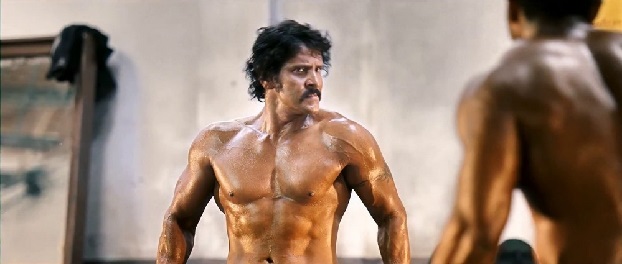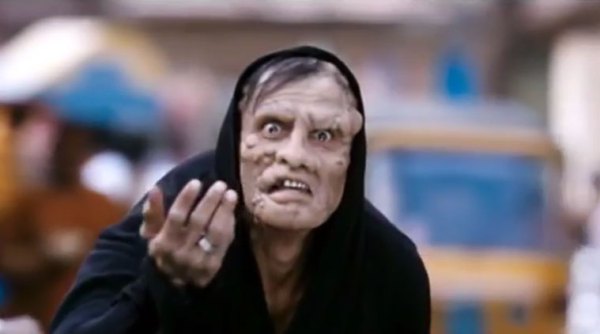Director Shankar doesn’t just have a vision. He has way too many of them. And he has decided to put them all in one film — his latest offering I. Returning after his 2010 Rajnikanth-Aishwarya Rai starrer Robot, Shankar stays true to his trademark style of grandiose, loud and unapologetically garish melodrama. Nothing is off limits here.
I stars Vikram as Lingesan, a happy-go-lucky bodybuilder who idolizes Arnold Schwarzenneger and dreams of winning the Mr. India competition. He’s also besotted with Diya (Amy Jackson, last seen in the forgettable Ek Deewana Tha), a model on an endorsing spree, appearing in commercials for everything from tea to sanitary napkins, all products that Lingesan collects obsessively.
Through a series of events, Lingesan is transformed into advertising model Lee. He’s hired to work with Diya in several high profile commercials. The two fall in love, but create several enemies along the way. As the story swooshes back and forth between past and present, we see Lingesan as both Lee (in the past) and a disfigured hunchback hell-bent on exacting revenge (in the present).
While I is not as wholly entertaining as Robot, Shankar throws every available trick, effect and outrageous idea at the audience in a film that stretches beyond three hours. This includes Lingesan flexing in a choreographed muscle show, wearing nothing but speedos, to the song “Azeem O Shaan Shehenshah” from Jodhaa Akbar. This quickly leads into a lengthy and bone-crunching fight sequence where Lingesan, oiled up and still in those speedos, thrashes an onslaught of other oiled up, musclemen also in speedos. That’s just the beginning of things to come.

Shankar’s films usually carry a loud message about social unjust or societal ills, championing a vigilante form of justice that usually stays well outside of the law. In ‘I‘ there’s commentary about the fickleness of cosmetic beauty and the beauty industry. The film questions if love can exist beyond physical beauty, but only in the case of the man (Diya remains flawlessly stunning throughout).
The message does fall into question, however as hunchback Lingesan’s calculated revenge schemes progress. These include some of the world’s most horrible genetic and physical deformities that are turned into punishments with which to make enemies suffer.
Perhaps the biggest issue with the film is the way it treats transphobia. Indian films have not had a good track record in dealing with LGBT characters and sadly, I is no different. Transgender real-life stylist Ojas Rajani plays Osma Jasmine, a stylist who transforms bodybuilder Lingesan into model Lee. In the process, she constantly showers her affections on him to which his response goes from amusing awkwardness to pure loathing.
This, in turn, makes her a villain and seemingly justifies the revenge Lingesan has planned for her. In a film that could otherwise be watched for its director’s eccentricities, it’s disappointing that such a plotline can be seen as acceptable.

As the main lead, Vikram carries the film entirely. To give credit where it’s due, very few mainstream Indian actors today would be willing to look disfigured and grotesque for more than half the film. Vikram essentially plays three characters — the bodybuilder, the model and the hunchback — proving his dedication to the film through every outlandish scene or set piece. Amy Jackson, as Diya, is mildly more expressive than in her debut film.
In a pre-release interview for the film, Shankar explained that he only included visual effects as required by the script. After watching I, it appears that the script was chewed up and spat out by the multitude of computers that put this film together. And with one of the world’s best special effects makeup team at his disposal — Weta Workshop (responsible for Lord of the Rings and The Hobbit trilogies) — why not go crazy.
The cinematography, by P.C. Sreeram, is impressive. He captures both the intimate and dark moments of the film with equal élan as the sweeping shots of breathtaking Chinese locales. The music by A.R. Rahman is rather bland and forgettable.
In some ways, a Shankar film is light years beyond anything a critic can express about it. It is something that cannot be fully described in words, because even if I tell you this film has a BMX bike gang fighting using aerial acrobatics, a thousand bees attacking a man covered in syrup, a Beauty and the Beast-themed musical number, a motorbike/barbell/Nokia phone/fish metamorphosing into a woman, and dozens of flying lips, that only just scratches the surface.
I won’t tell you to not watch the film, but if you do, you may want to smoke something or get drunk before you do. And most likely afterwards too.
Pulkit Datta is a writer and filmmaker based in New York City. He has written extensively on cinema and culture, and also independently writes and produces feature films, documentaries and shorts. Follow him on Twitter @PulkitDatta.













Hi Mr. Dutta,
Your review of ‘I’ was good except for the last few words. you cannot review the taste of indian audience sitting in new york while eating a burger. only one point is more than enough for people to go and watch the movie that is Vikram’s dedicated performance. may be it was little bit higher or lower in expression in few scenes but still it was one of the best watchable performances by Vikram.
As far as the issue of transgenders ; why you people don’t see that Shankar has given more importance for the role of Osma played by Ojas rajani than the heroine played by Emy.
About Shankar: Shankar has under played himself in the sense of the storyline (regular revenge) which could have been better if done in 2000. but in the whole history of cinema revenge is always present in it.
At the same time the visuals and technical side of the movie still adds another feather to Shankar’s Hat.
Comparable to the regular rubbish bollywood movies which as you said can be watched only after boozing and smoking. Shankar’s ‘I’ can be watched with the whole family.